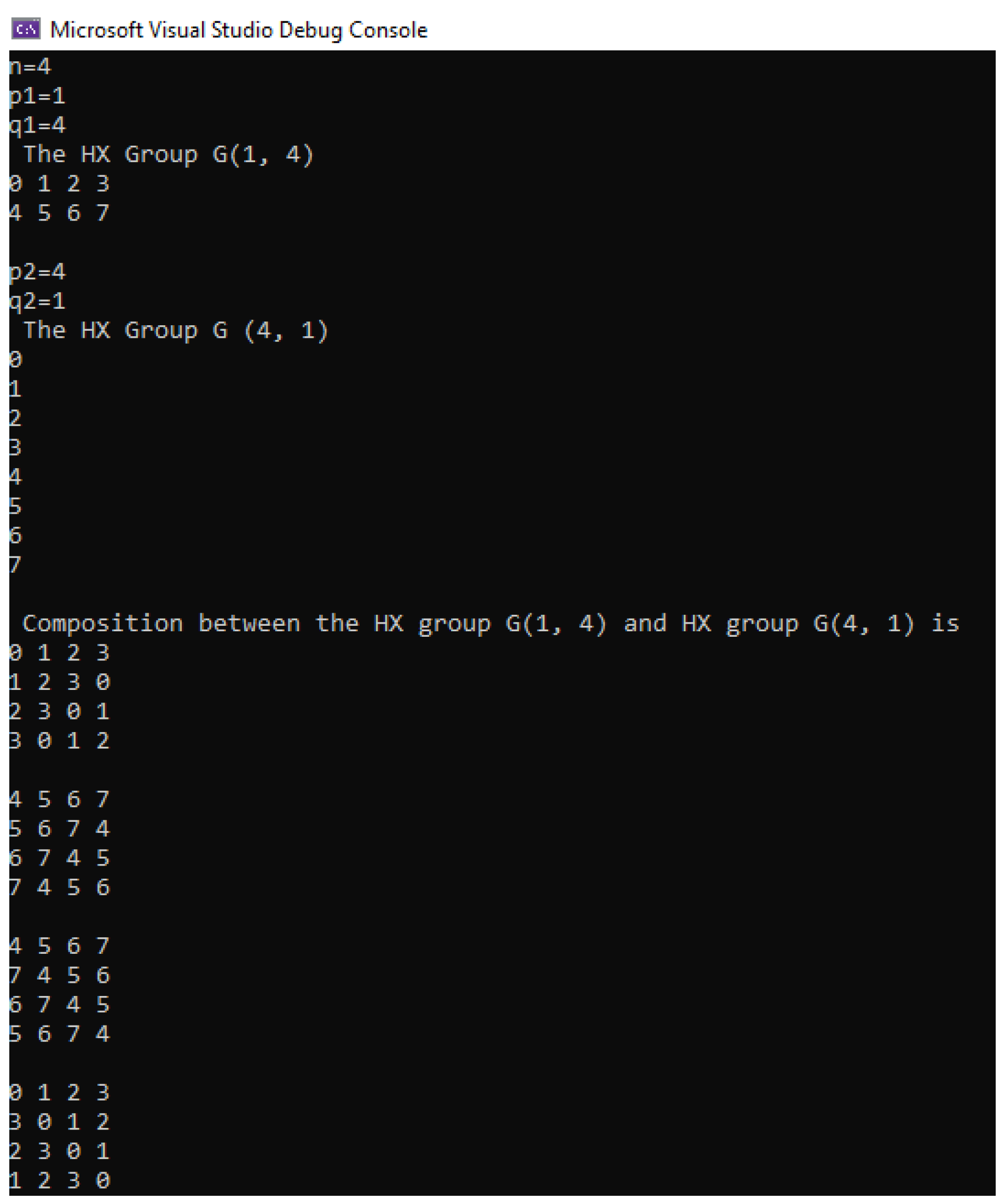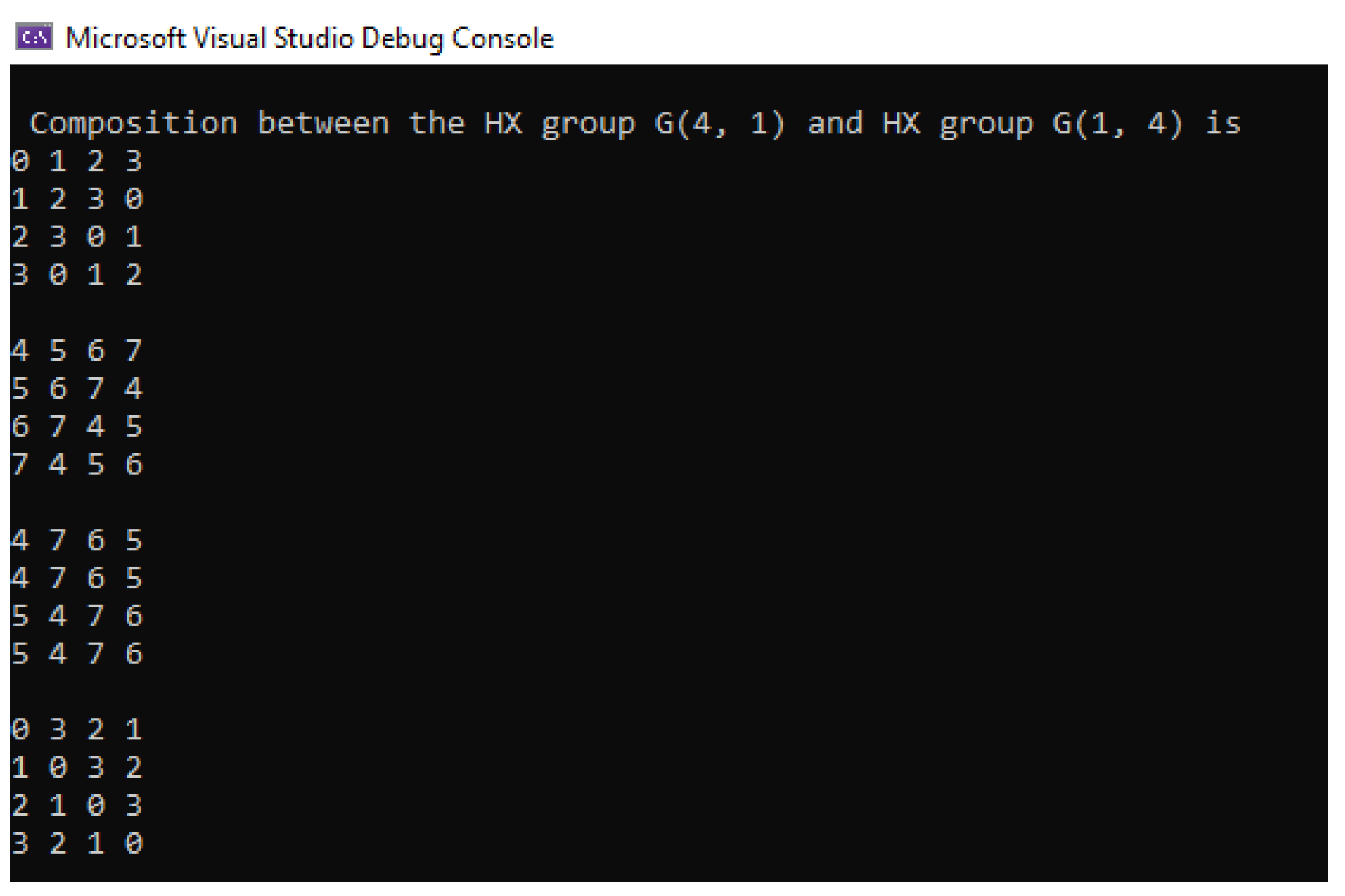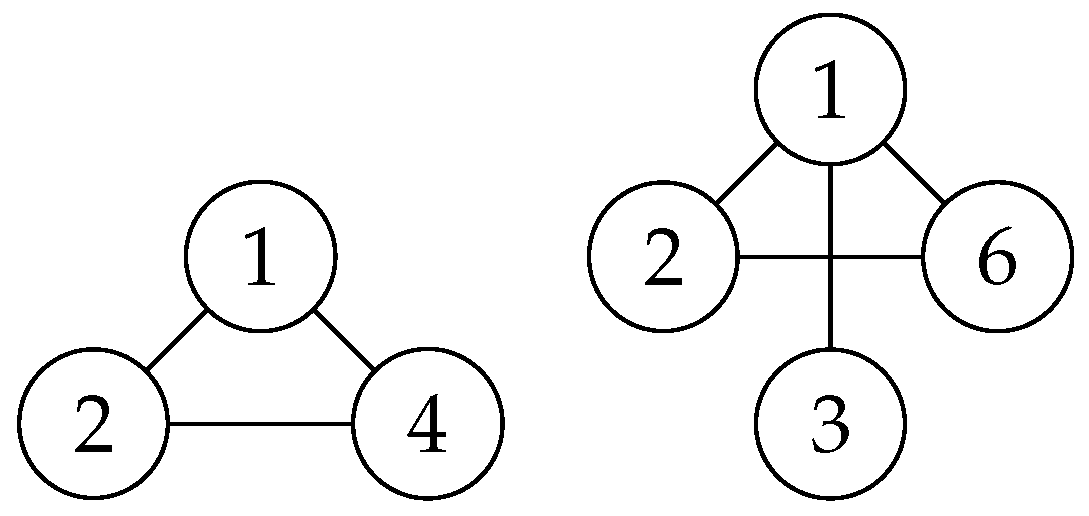Optimizing HX-Group Compositions Using C++: A Computational Approach to Dihedral Group Hyperstructures
Abstract
1. Introduction
2. The Construction of the Hyperstructure
3. Materials and Methods
Implementing Code into Microsoft Visual Studio 2022
| #include<iostream> |
| #include<stdio.h> |
| #include<algorithm> |
| using namespace std; |
| int main() |
| { |
| int n, i, j, p1, q1, p2, q2, k, l, s, t, a[100][100], |
| b[100][100],c[200],p,d,e,aux,v[200][200],x, m; |
| cout << "n="; |
| cin >> n; cout << "p1="; |
| cin >> p1;cout << "q1="; |
| cin >> q1; |
| if (n == p1 * q1) |
| { |
| cout << "The HX Group G(" << p1 << ", " << q1 << ")" << endl; |
| for (i = 0; i < 2 * p1; i++) |
| { |
| for (j = 0; j < q1; j++) |
| { |
| if (i < p1) |
| a[i][j] = i + j * p1; |
| else |
| a[i][j] = i + n - p1 + j * p1; |
| cout << a[i][j] << " "; |
| } |
| cout << endl; |
| } |
| } |
| cout << endl; |
| cout << "p2="; cin >> p2; |
| cout << "q2="; cin >> q2; |
| if (n == p2 * q2) |
| { |
| cout << "The HX Group G (" << p2 << ", " << q2 << ")" << endl; |
| d = 2 * p2; |
| for (i = 0; i < 2 * p2; i++) |
| { |
| for (j = 0; j < q2; j++) |
| { |
| if (i < p2) |
| b[i][j] = i + j * p2; |
| else |
| b[i][j] = i + n - p2 + j * p2; |
| cout << b[i][j] << " "; |
| } |
| cout << endl; |
| } |
| cout << endl; |
| } |
| if ((n == p1 * q1)&&(n == p2 * q2)) |
| { |
| cout << "Composition between the HX group G(" << p1<< |
| ", " << q1 << ") and HX group G(" << p2 << ", " << q2 << |
| ") is " << endl; |
| m = p1 * p2; |
| for (p = 0; p < p1 * p2; p++) |
| { |
| for (j = 0; j < q1; j++) |
| { |
| for (t = 0; t < q2; t++) |
| { |
| c[p] = (a[p / p2][j] + b[p % p2][t]) % n; |
| cout << c[p] << " "; |
| } |
| } |
| cout << endl; |
| } |
| cout << endl; |
| cout << endl; |
| for (p = p1 * p2; p < 2 * p1 * p2; p++) |
| { |
| for (j = 0; j < q1; j++) |
| { |
| for (t = 0; t < q2; t++) |
| { |
| c[p] = (a[p / p2][j] + b[p % p2][t]) % n + n; |
| cout << c[p] << " "; |
| } |
| } |
| cout << endl; |
| } |
| cout << endl; |
| for (p = 2 * p1 * p2; p < 3 * p1 * p2; p++) |
| { |
| for (j = 0; j < q1; j++) |
| { |
| for (t = 0; t < q2; t++) |
| { |
| c[p] = ((a[p1 + p % p1][j] - b[p % p2][t]) % n) + n; |
| cout << c[p] << " "; |
| } |
| } |
| cout << endl; |
| } |
| cout << endl; |
| for (p = 3 * p1 * p2; p < 4 * p1 * p2; p++) |
| { |
| for (j = 0; j < q1; j++) |
| { |
| for (t = 0; t < q2; t++) |
| { |
| c[p] = ((a[p1 + p % p1][j] - b[p2 + p % p2][t]) + n) % n; |
| cout << c[p] << " "; |
| } |
| } |
| cout << endl; |
| } |
| cout << endl; |
| cout << " Composition between the HX group G(" << |
| p2 << ", " << q2 <<") and HX group G(" << p1 << ", " |
| << q1 << ") is " << endl; |
| e = 2 * p1; |
| for (p = 0; p < p1 * p2; p++) |
| { |
| for (j = 0; j < q2; j++) |
| { |
| for (t = 0; t < q1; t++) |
| { |
| c[p] = (b[p / p1][j] + a[p % p1][t]) % n; |
| cout << c[p] << " "; |
| } |
| } |
| cout << endl; |
| } |
| cout << endl; |
| for (p = p1 * p2; p < 2 * p1 * p2; p++) |
| { |
| for (j = 0; j < q2; j++) |
| { |
| for (t = 0; t < q1; t++) |
| { |
| c[p] = (b[p / p1][j] + a[p % p1][t]) % n + n; |
| cout << c[p] << " "; |
| } |
| } |
| cout << endl; |
| } |
| cout << endl; |
| for (p = 2 * p1 * p2; p < 3 * p1 * p2; p++) |
| { |
| for (j = 0; j < q2; j++) |
| { |
| for (t = 0; t < q1; t++) |
| { |
| c[p] = (b[p / e][j] - a[p % p1][t]) % n + n; |
| cout << c[p] << " "; |
| } |
| } |
| cout << endl; |
| } |
| cout << endl; |
| for (p = 3 * p1 * p2; p < 4 * p1 * p2; p++) |
| { |
| for (j = 0; j < q2; j++) |
| { |
| for (t = 0; t < q1; t++) |
| { |
| c[p] = ((b[p2 + p % p2][j] - a[p1 + p % p1][t]) + n) % n; |
| cout << c[p] << " "; |
| } |
| } |
| cout << endl; |
| } |
| cout << endl; |
| } |
| } |
4. Results
4.1. The Results Are Provided by the Code Implemented for
4.2. A Graph Representation of the HX-Groups with Dihedral Group as Support
5. Discussion
Author Contributions
Funding
Data Availability Statement
Acknowledgments
Conflicts of Interest
References
- Marty, F. Sur une generalization de la notion de group. In Proceedings of the Congress of Scandinavian Mathematicians, Stockholm, Sweden, 14–18 August 1934; pp. 45–49. [Google Scholar]
- Corsini, P.; Leoreanu, V. Applications of Hyperstructures Theory; Kluwer Academic Publishers: Boston, MA, USA; Dordrecht, The Netherlands; London, UK, 2003. [Google Scholar]
- Davvaz, B.; Cristea, I. Fuzzy Algebraic Hyperstructures—An Introduction; Studies in Fuzziness and Soft Computing; Springer: Cham, Switzerland, 2015; Volume 321. [Google Scholar]
- Kalampakas, A.; Spartalis, S.; Tsigkas, A. The Path Hyperoperation. An. Şt. Univ. Ovidius Constanţa 2014, 22, 141–153. [Google Scholar] [CrossRef]
- Linzi, A.; Cristea, I. Dependence Relations and Grade Fuzzy Set. Symmetry 2023, 15, 311. [Google Scholar] [CrossRef]
- Massourous, C.; Mittas, J. Languages-automata and hypercompositional structure. In Algebraic Hyperstructures and Applications, Proceeding of the 4th International Congress, Xanthi, Greece, 27–30 June 1990; World Scientific: Singapore, 1991; pp. 137–147. [Google Scholar]
- Vougiouklis, T. On some representations of hypergroups. Ann. Sci. L’Univ. Clermont Mathématiques 1990, 95, 21–29. [Google Scholar]
- Tofan, I.; Volf, A.C. On some conections between; hyperstructures and fuzzy sets. Ital. J. Pure Appl. Math. 2000, 7, 63–68. [Google Scholar]
- Li, H.X.; Duan, Q.Z.; Wang, P.Z.; Wang, P.Z. Hypergroup(I). BUSEFAL 1985, 23, 22–29. [Google Scholar]
- Li, H.X. HX-groups. BUSEFAL 1987, 33, 31–37. [Google Scholar]
- Zhenliang, Z. The properties of HX-groups. Italian J. Pure Appl. Math. 1997, 2, 97–106. [Google Scholar]
- Corsini, P. HX-groups and Hypergroups. An. Şt. Univ. Ovidius Constanţa 2016, 24, 101–121. [Google Scholar] [CrossRef]
- Corsini, P. HX-Hypergroups associated with the direct product of some Z/nZ. J. Algebr. Struct. Their Appl. 2016, 3, 1–15. [Google Scholar]
- Corsini, P. Hypergroups associated with HX-groups. An. Şt. Univ. Ovidius Constanţa 2017, 25, 49–64. [Google Scholar] [CrossRef]
- Cristea, I.; Novák, M.; Onasanya, B.O. Links Between HX-Groups and Hypergroups. Algebra Coll. 2021, 28, 441–452. [Google Scholar] [CrossRef]
- Sonea, A. HX-groups associated to the dihedral group Dn. J. Mult. Valued Log. Soft Comput. 2019, 33, 11–26. [Google Scholar]
- Sonea, A. A Way to Construct Commutative Hyperstructures. Comput. Sci. Math. Forum. 2023, 7, 22. [Google Scholar] [CrossRef]
- Sonea, A.; Al-Kaseasbeh, S. An introduction to NeutroHX-Groups. In Theory and Applications of NeutroAlgebras as Generalizations of Classical Algebras; IGI Global Publishing Tomorrow’s Research Today: Hershey, PA, USA, 2022. [Google Scholar] [CrossRef]
- Mousavi, S.S.; Jafarpour, M.; Cristea, I. From HX-Groups to HX-Polygroups. Axioms 2024, 13, 7. [Google Scholar] [CrossRef]
- Rotman, J.J. An Introduction to the Theory of Groups; Springer: New York, NY, USA, 1995. [Google Scholar]
- Cristea, I.; Kocijan, J.; Novák, M. Introduction to Dependence Relations and Their Links to Algebraic Hyperstructures. Mathematics 2019, 7, 885. [Google Scholar] [CrossRef]
- Kalampakas, A.; Spartalis, S. Hyperoperations on directed graphs. J. Discret. Math. Sci. Cryptogr. 2023, 27, 1011–1025. [Google Scholar] [CrossRef]



Disclaimer/Publisher’s Note: The statements, opinions and data contained in all publications are solely those of the individual author(s) and contributor(s) and not of MDPI and/or the editor(s). MDPI and/or the editor(s) disclaim responsibility for any injury to people or property resulting from any ideas, methods, instructions or products referred to in the content. |
© 2024 by the authors. Licensee MDPI, Basel, Switzerland. This article is an open access article distributed under the terms and conditions of the Creative Commons Attribution (CC BY) license (https://creativecommons.org/licenses/by/4.0/).
Share and Cite
Sonea, A.P.; Chiruţă, C. Optimizing HX-Group Compositions Using C++: A Computational Approach to Dihedral Group Hyperstructures. Mathematics 2024, 12, 3492. https://doi.org/10.3390/math12223492
Sonea AP, Chiruţă C. Optimizing HX-Group Compositions Using C++: A Computational Approach to Dihedral Group Hyperstructures. Mathematics. 2024; 12(22):3492. https://doi.org/10.3390/math12223492
Chicago/Turabian StyleSonea, Andromeda Pătraşcu, and Ciprian Chiruţă. 2024. "Optimizing HX-Group Compositions Using C++: A Computational Approach to Dihedral Group Hyperstructures" Mathematics 12, no. 22: 3492. https://doi.org/10.3390/math12223492
APA StyleSonea, A. P., & Chiruţă, C. (2024). Optimizing HX-Group Compositions Using C++: A Computational Approach to Dihedral Group Hyperstructures. Mathematics, 12(22), 3492. https://doi.org/10.3390/math12223492






